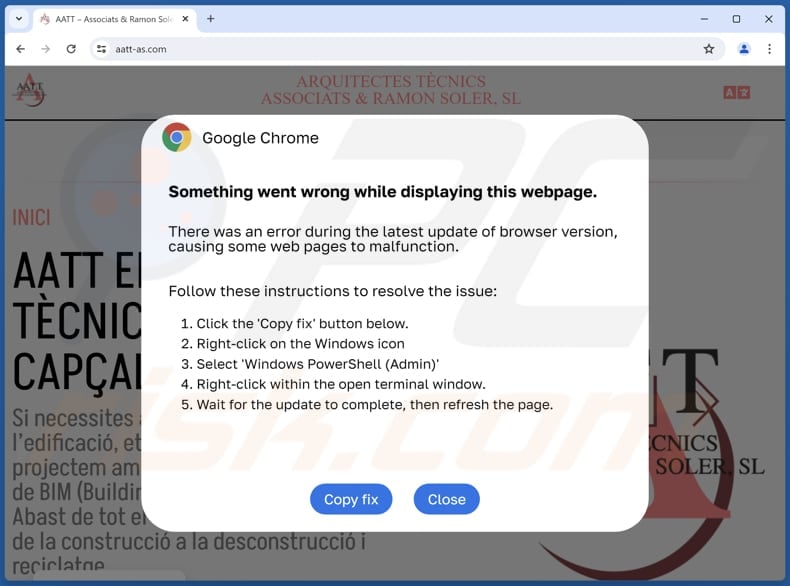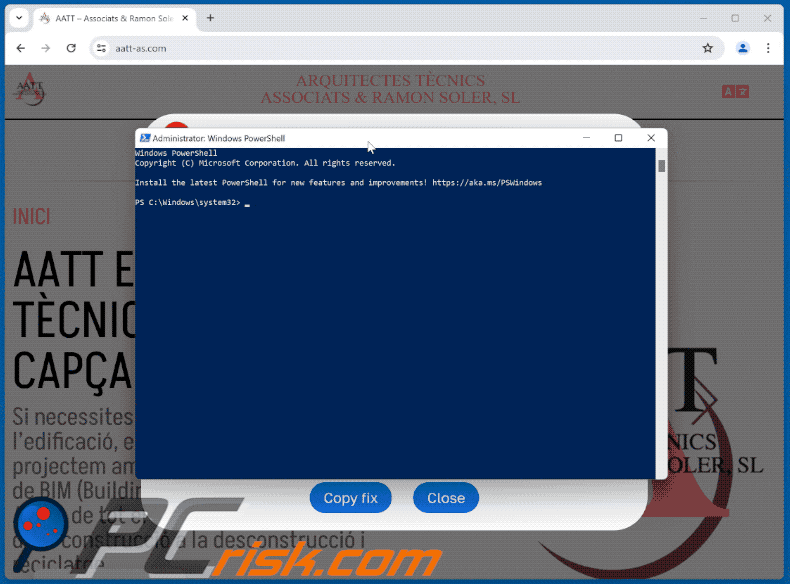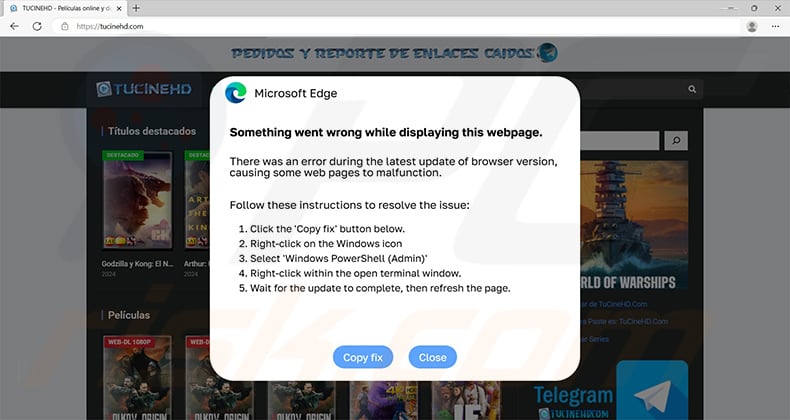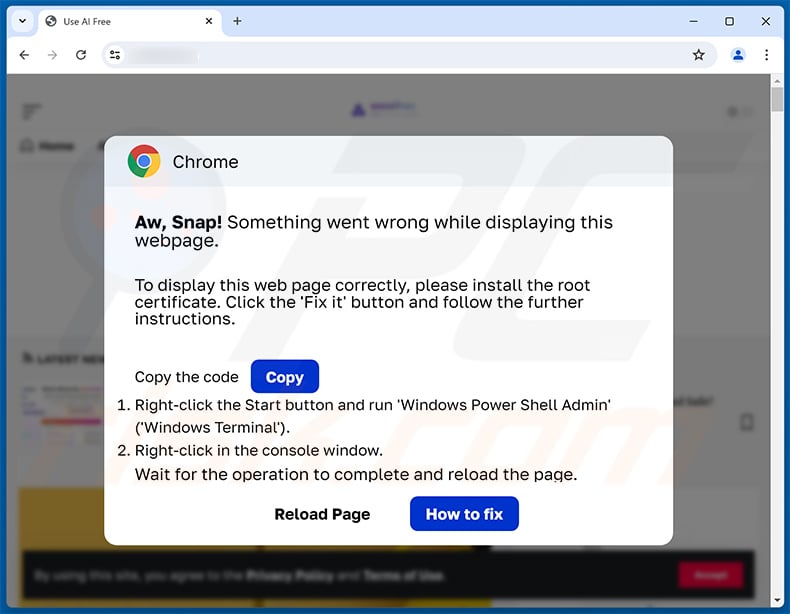How to avoid falling for scams like "Something Went Wrong While Displaying This Webpage"
Phishing/ScamAlso Known As: Something Went Wrong While Displaying This Webpage scam
Get free scan and check if your device is infected.
Remove it nowTo use full-featured product, you have to purchase a license for Combo Cleaner. Seven days free trial available. Combo Cleaner is owned and operated by RCS LT, the parent company of PCRisk.com.
What kind of scam is "Something Went Wrong While Displaying This Webpage"?
Our analysis of the error message has shown that it is a fraudulent pop-up designed to trick visitors into believing that they have encountered an error and must resolve the "issue". Scammers use it to deploy malware on computers. Thus, this (and similar pop-ups) should be ignored to avoid potential consequences. This scam is part of the ClickFix campaign.

"Something Went Wrong While Displaying This Webpage" scam overview
The web page displays a fake alert (supposedly from Google Chrome) claiming that something went wrong while displaying the page. It says that there was an error during the latest update of the browser version, causing some websites to malfunction. The site instructs visitors to follow the provided steps to resolve the "issue".
Now it is worth noting that the "Something Went Wrong While Displaying This Webpage" pop-up message may be displayed by legitimate websites hijacked by cyber criminals. It is a common tactic to use completely legitimate hijacked sites to display various scam messages and spread malware.
These steps include clicking the "Copy fix" button, right-clicking on the Windows icon, selecting "Window PowerShell (Admin)", then right-clicking the open terminal window and waiting for the supposed update to complete, and then refreshing the site.
However, following these steps results in the execution of a malicious PowerShell script through the automation and configuration management tool. This ultimately leads to the installation of malware. Malware distributed through such methods may include ransomware, Trojans, spyware, keystroke loggers, cryptocurrency miners, and other forms of malware.
Functionality of the malware
Ransomware encrypts the victim's files and demands a ransom for the decryption tool. Trojans provides unauthorized access to the victim's system and enable threat actors to perform malicious actions, for instance, to inject additional payloads. Spyware collects sensitive information from the victim's system.
Keyloggers records keystrokes (keyboard input) to capture a variety of sensitive information such as login credentials, credit card details, and more. Crypto miners use the infected device's resources to mine cryptocurrencies without the user's consent.
| Name | Something Went Wrong While Displaying This Webpage scam |
| Threat Type | Phishing, Scam, Social Engineering, Fraud |
| Fake Claim | There was an error during the latest update of the browser version |
| Disguise | Legitimate alerts from Google Chrome |
| Related Domain | aatt-as[.]com, bostoninstituteofanalytics[.]org |
| Detection Names (aatt-as[.]com) | N/A (VirusTotal) |
| Symptoms | Fake error messages, fake system warnings, pop-up errors, hoax computer scan. |
| Distribution methods | Compromised websites, rogue online pop-up ads, potentially unwanted applications. |
| Damage | Loss of sensitive private information, monetary loss, identity theft, possible malware infections. |
| Malware Removal (Windows) |
To eliminate possible malware infections, scan your computer with legitimate antivirus software. Our security researchers recommend using Combo Cleaner. Download Combo CleanerTo use full-featured product, you have to purchase a license for Combo Cleaner. 7 days free trial available. Combo Cleaner is owned and operated by RCS LT, the parent company of PCRisk.com. |
Possible damage
Following the instructions provided by the page described in our article can have multiple negative consequences. For instance, victims may lose their files, money, access to personal accounts, or become victims of identity theft. Therefore, it is strongly recommended not to trust web pages of this kind to avoid potential issues.
Some examples of similar scams are "Please Install The Root Certificate", "Microsoft Detected A Unusual Application In Your System", and "McAfee Safety Warning".
How did I open a scam website?
Typically, scam websites are accessed through other pages that use rogue advertising networks (e.g., torrent sites or illegal movie streaming pages), notifications from untrustworthy websites, and fake warnings/alerts. Also, these deceptive sites can be opened via misleading ads and pop-ups, fake buttons, and similar content provided by dubious websites.
Additionally, scammers may lure users into visiting scam websites via email (by sending fraudulent links). In other cases, users may land on scam pages by clicking ads originating from rogue advertising-supported software.
How to avoid visiting scam pages?
Do not interact with notifications or alerts from untrustworthy websites. Steer clear of ads, pop-ups, buttons, and similar content encountered on dubious websites. Be wary of links in emails, especially from unknown senders, as scammers often use fraudulent links to lure users to scam websites.
Use official pages and app stores for downloads. Keep the operating system and programs up to date, and use a reputable antivirus or anti-malware tool. If your computer is already infected with unwanted apps, we recommend running a scan with Combo Cleaner Antivirus for Windows to automatically eliminate them.
The appearance of "Something Went Wrong While Displaying This Webpage" pop-up scam (GIF):

Text in the fraudulet message:
Google Chrome
Something went wrong while displaying this webpage.
There was an error during the latest update of browser version, causing some web pages to malfunction.
Follow these instructions to resolve the issue:
1. Click the 'Copy fix' button below.
2. Right-click on the Windows icon
3. Select 'Windows PowerShell (Admin)'
4. Right-click within the open terminal window.
5. Wait for the update to complete, then refresh the page.
Screenshot of this scam pop-up targeting Microsoft Edge browser and spreading Lumma Stealer:

Another variant of "Something Went Wrong While Displaying This Webpage" pop-up scam:

Instant automatic malware removal:
Manual threat removal might be a lengthy and complicated process that requires advanced IT skills. Combo Cleaner is a professional automatic malware removal tool that is recommended to get rid of malware. Download it by clicking the button below:
DOWNLOAD Combo CleanerBy downloading any software listed on this website you agree to our Privacy Policy and Terms of Use. To use full-featured product, you have to purchase a license for Combo Cleaner. 7 days free trial available. Combo Cleaner is owned and operated by RCS LT, the parent company of PCRisk.com.
Quick menu:
- What is Something Went Wrong While Displaying This Webpage scam?
- How to identify a pop-up scam?
- How do pop-up scams work?
- How to remove fake pop-ups?
- How to prevent fake pop-ups?
- What to do if you fell for a pop-up scam?
How to identify a pop-up scam?
Pop-up windows with various fake messages are a common type of lures cybercriminals use. They collect sensitive personal data, trick Internet users into calling fake tech support numbers, subscribe to useless online services, invest in shady cryptocurrency schemes, etc.
While in the majority of cases these pop-ups don't infect users' devices with malware, they can cause direct monetary loss or could result in identity theft.
Cybercriminals strive to create their rogue pop-up windows to look trustworthy, however, scams typically have the following characteristics:
- Spelling mistakes and non-professional images - Closely inspect the information displayed in a pop-up. Spelling mistakes and unprofessional images could be a sign of a scam.
- Sense of urgency - Countdown timer with a couple of minutes on it, asking you to enter your personal information or subscribe to some online service.
- Statements that you won something - If you haven't participated in a lottery, online competition, etc., and you see a pop-up window stating that you won.
- Computer or mobile device scan - A pop-up window that scans your device and informs of detected issues - is undoubtedly a scam; webpages cannot perform such actions.
- Exclusivity - Pop-up windows stating that only you are given secret access to a financial scheme that can quickly make you rich.
Example of a pop-up scam:

How do pop-up scams work?
Cybercriminals and deceptive marketers usually use various advertising networks, search engine poisoning techniques, and shady websites to generate traffic to their pop-ups. Users land on their online lures after clicking on fake download buttons, using a torrent website, or simply clicking on an Internet search engine result.
Based on users' location and device information, they are presented with a scam pop-up. Lures presented in such pop-ups range from get-rich-quick schemes to fake virus scans.
How to remove fake pop-ups?
In most cases, pop-up scams do not infect users' devices with malware. If you encountered a scam pop-up, simply closing it should be enough. In some cases scam, pop-ups may be hard to close; in such cases - close your Internet browser and restart it.
In extremely rare cases, you might need to reset your Internet browser. For this, use our instructions explaining how to reset Internet browser settings.
How to prevent fake pop-ups?
To prevent seeing pop-up scams, you should visit only reputable websites. Torrent, Crack, free online movie streaming, YouTube video download, and other websites of similar reputation commonly redirect Internet users to pop-up scams.
To minimize the risk of encountering pop-up scams, you should keep your Internet browsers up-to-date and use reputable anti-malware application. For this purpose, we recommend Combo Cleaner Antivirus for Windows.
What to do if you fell for a pop-up scam?
This depends on the type of scam that you fell for. Most commonly, pop-up scams try to trick users into sending money, giving away personal information, or giving access to one's device.
- If you sent money to scammers: You should contact your financial institution and explain that you were scammed. If informed promptly, there's a chance to get your money back.
- If you gave away your personal information: You should change your passwords and enable two-factor authentication in all online services that you use. Visit Federal Trade Commission to report identity theft and get personalized recovery steps.
- If you let scammers connect to your device: You should scan your computer with reputable anti-malware (we recommend Combo Cleaner Antivirus for Windows) - cyber criminals could have planted trojans, keyloggers, and other malware, don't use your computer until removing possible threats.
- Help other Internet users: report Internet scams to Federal Trade Commission.
Frequently Asked Questions (FAQ)
What is a pop-up scam?
A pop-up scam usually involves fake messages (e.g., alerts or warnings), often posing as notifications from legitimate security tools, operating systems, or other software.
What is the purpose of a pop-up scam?
Scammers use these scams to trick users into downloading and executing malware, sending money, providing sensitive information, or taking other actions.
Why do I encounter fake pop-ups?
Web pages hosting pop-up scams can be encountered in various ways. Typically, users land on such pages by visiting sites associated with rogue advertising networks (e.g., torrent sites), clicking deceptive advertisements and pop-ups, or opening links in fraudulent emails. Interacting with notifications from dubious pages and clicking ads generated by adware can also lead to scams.
Will Combo Cleaner protect me from pop-up scams?
Combo Cleaner is designed to scan every website you visit, detecting any malicious ones. It also identifies sites intended to deliver pop-up scams, providing immediate warnings and restricting access to these sites.
Share:

Tomas Meskauskas
Expert security researcher, professional malware analyst
I am passionate about computer security and technology. I have an experience of over 10 years working in various companies related to computer technical issue solving and Internet security. I have been working as an author and editor for pcrisk.com since 2010. Follow me on Twitter and LinkedIn to stay informed about the latest online security threats.
PCrisk security portal is brought by a company RCS LT.
Joined forces of security researchers help educate computer users about the latest online security threats. More information about the company RCS LT.
Our malware removal guides are free. However, if you want to support us you can send us a donation.
DonatePCrisk security portal is brought by a company RCS LT.
Joined forces of security researchers help educate computer users about the latest online security threats. More information about the company RCS LT.
Our malware removal guides are free. However, if you want to support us you can send us a donation.
Donate
▼ Show Discussion